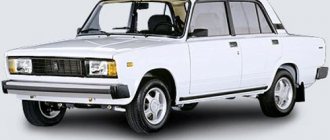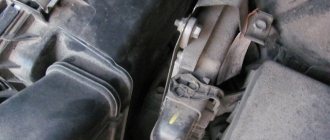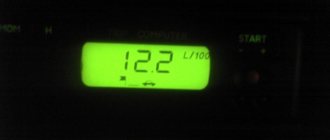How to Reduce Fuel Consumption VAZ 2107 Carburetor
Reducing fuel consumption of VAZ 2107
When buying a car, some future buyers look not so much at good dynamics and acceleration, but at fuel consumption.
The fuel consumption of the VAZ 2107 is quite moderate, and according to this parameter the car can be considered for purchase, however, many reasons depend on how quickly the gasoline leaves the tank, including driving style.
VAZ 2107: fuel consumption per 100 km
The VAZ-2107 was equipped with various engines, starting with the configuration, and the following models were produced with carburetor engines:
- 2107 - ICE 2103 1.5 l;
- 21071 - ICE 2101 1.2.7 l;
- 21072 - ICE 2105 1.3 l;
- 21074 - ICE 2106 1.6L
The fuel consumption (RT) of cars with carburetor power units depends on the engine size - the smaller the cylinder volume, the lower the fuel consumption. According to technical data for the VAZ-2107, fuel consumption per 100 km is:
- on the highway - 6.8 l (at a speed of 90 km/h);
- in city mode - 9.6 liters.
CT increases sharply with acceleration, so at 120 km/h 9.5 liters of gasoline are consumed per 100 km. For VAZ-21074 cars with a 2106 engine, RT standards are slightly different:
- in the suburbs - 6.9 l / 100 km;
- within the city - 10.4.5 l / 100 km.
How to reduce fuel consumption on Vas 2110.
VAZ 2105
No idle speed for VAZ 2107 carburetor reasons. idle speed of vaz 2107 carb disappeared
“Five” is considered a legend of the domestic automobile industry, since its production continued for more than three decades. The first VAZ 2105 rolled off the assembly line in 1979, and the last representative left the factory gates in 2010. In the Soviet era, the “five” was considered a luxury item, and at the beginning of the new century it was the most affordable car, since its cost did not go beyond 180 thousand rubles.
The 2105 was equipped with one of four options for gasoline engines or a diesel engine. In power units with a volume of 1.2 and 1.3 liters, the fuel supply was provided by a carburetor, and injectors were installed on the 1.5-liter versions. Models with 1.6-liter engines could have both carburetors and injectors. All engines were paired with a five-speed manual transmission.
| Engine | Consumption (city) | Consumption (highway) | Flow (mixed) | Type of fuel |
| 1.2 MT 64 hp | 10.0 | 6.3 | 7.4 | Petrol |
| 1.3 MT 63 hp | 9.4 | 6.8 | 7.2 | |
| 1.3 MT 64 hp | 9.4 | 6.8 | 7.2 | |
| 1.3 MT 140 hp | 10.2 | 6.2 | 7.8 | |
| 1.5 MT 71 hp | 9.6 | 7.3 | 8.8 | |
| 1.5 MT 75 hp | 10.2 | 7.4 | 10.0 | |
| 1.6 MT 73 hp | 10.0 | 6.8 | 8.5 | |
| 1.6 MT 74 hp | 9.6 | 7.0 | 8.5 | |
| 1.5 MT 50 hp | 6.7 | 5.8 | 6.0 | Diesel |
Fuel consumption of the VAZ 2107: what it depends on and how to reduce it
“Seven” cannot be classified as a “gluttonous” car. However, current gasoline prices make even small car owners think about fuel consumption. The fuel consumption of the VAZ 2107 depends on many factors, ranging from the type and condition of the engine to driving style. To know how to save on fuel, let's look at these issues in more detail.
VAZ 2107: fuel consumption per 100 kilometers
The generally accepted parameter characterizing the “gluttony” of a car - fuel consumption per 100 kilometers - differs significantly even for one model. First of all, fuel consumption depends on driving mode and speed. In the city cycle, when you often have to accelerate and then brake at traffic lights, gasoline is consumed much faster than when driving on the highway. But even on the track you can get completely different performance from one car. At a speed of 80-90 km/h, air resistance is small, and accordingly, consumption is minimal. The higher the speed, the more energy has to be spent to overcome resistance to air flow. The VAZ 2107 does not have good aerodynamics, so the difference in fuel consumption when driving at a speed of 90 and 120 km/h is almost 40%. Consumption is also affected by other parameters: engine condition, fuel quality, tire pressure, road surface quality, etc. You can approximately find out what fuel consumption a VAZ 2107 has from the manufacturer’s specifications. However, in reality the consumption is always slightly higher.
Proper Fuel Saving Techniques
To ensure that the RT is not too large, it is first necessary to monitor the technical condition of the car. Even the condition of the braking system affects increased fuel consumption - if one of the working cylinders is faulty, the car will begin to slow down, and the driving resistance will increase in this case.
It is important to maintain the required tire pressure - when it decreases, resistance also increases, and accordingly, fuel consumption increases by 2-4%, it all depends on how low the tires are. But it’s also not worth over-inflating the tires - the car starts to drive harshly, and even on a slippery road, the braking distance increases
If malfunctions appear in the engine or fuel system, you need to carry out diagnostics to find out the cause of the problem. And adjusting the carburetor and setting up the fuel injection system should be trusted to specialists.
Fuel consumption VAZ 2107 (carburetor)
AvtoVAZ managed to release 4 variations of the carburetor “seven” with engine capacities of 1.2, 1.3, 1.5 and 1.6 liters. The larger the engine size, the more gasoline it will burn. Thus, the one and a half liter engine burns 6.8 l/100 km when driving on the highway and 9.6 l/100 km during city trips. For a VAZ 2107 with a 1.6 liter engine, these figures are respectively 6.9 and 10.2 l/100 km. Cars with 1.2 and 1.3 liter engines are more economical, but not as popular due to less power. It is worth noting that the fuel consumption of a VAZ 2107 (carburetor) with a four-speed gearbox is higher than that of a similar model with a five-speed gearbox.
OTHER FACTORS AFFECTING FUEL CONSUMPTION
In addition to climatic conditions and the age of the car, many other factors affect fuel consumption. It is not possible to list them all in one short article, so we will focus only on the most basic ones, the influence of which the driver can reduce.
LOW TIRE PRESSURE AS ONE OF THE FACTORS OF HIGH GASOLINE CONSUMPTION
Like any other car, the VAZ 2107 has tire pressure standards depending on the load. For standard 175–70R13 tires these figures are as follows:
- if there are 3 people in the cabin, then the pressure in the front tire should be 1.7 bar, in the rear tire - 2.1 bar;
- if there are 4–5 people in the cabin and there is cargo in the trunk, then the pressure in the front tire should be at least 1.9 bar, in the rear 2.3 bar.
Any downward deviation from the above values inevitably leads to increased fuel consumption. This is due to the fact that a flat tire has a significantly larger contact patch with the road. In this case, rolling friction increases significantly and the engine is forced to burn more fuel in order to overcome this friction.
Fuel consumption VAZ 2107 (injector)
The injection “sevens” were equipped with 3 engine options, and one of them differed only in the degree of compliance with environmental standards: 1.5 l, 1.6 (euro-2) and 1.6 (euro-3). Installing an injector did not significantly reduce fuel consumption. The injection system had a greater impact on power and dynamics. Fuel consumption of a VAZ 2107 (injector) with a 1.6-liter engine is 7.3 and 9.7 l/100 km when driving on the highway and in the city, respectively. This is slightly less than its carburetor counterpart. If we take into account that the injector is more “capricious and finicky” in terms of fuel quality and settings requirements, then the advantage in fuel consumption is completely leveled out. How can you reduce the fuel consumption of a VAZ 2107? All advice can be divided into two groups: real, which bring practical benefits, and dubious, which only benefit sellers of “smart” devices for reducing fuel consumption. First, about the “good”, that is, about the correct and effective methods of saving.
How to reduce fuel consumption
- Change your driving style, try to avoid sudden acceleration and braking. Try not to drive too fast, even on highways. Dynamic driving requires much more gasoline than calm driving.
- Monitor the condition of the ignition system. If the engine “troubles” or there is a weak spark in the cylinders, if the advance angle is incorrectly set, more fuel is consumed.
- Monitor the condition of the engine. Poor compression reduces engine efficiency.
- Check and adjust the carburetor or injection system regularly. The more precise the settings, the closer the current fuel consumption figures will be to the factory settings.
- Monitor tire pressure, as half-flat tires greatly increase rolling resistance.
Questionable ways to reduce fuel consumption
Traders offer all sorts of miraculous magnetic activators or fuel additives that supposedly significantly reduce fuel consumption. Magnetic fields do not affect the combustion process of gasoline. Additives also cannot greatly affect the efficiency of the engine, otherwise they would first of all be used in aviation and in cargo transportation, because fuel costs there are much higher than when driving small cars.
Experiments with additives are perhaps even more dangerous. If there is at least no harm from the magnets, then the additives can ruin the fuel system or damage the engine. Also, do not follow the advice to use cheap gasoline instead of expensive one. The use of low-octane gasoline will increase consumption rates and lead to accelerated engine wear.
Tire pressure
The last reason is one of the most common - low tire pressure. To make it clearer, just lower the wheels of the car and try to push it. Everyone knows that this will be extremely difficult.
The same situation occurs with the engine when it tries to move a car with flat tires. It has to expend more energy, which means it needs more fuel.
Now it’s clear why the VAZ 2107 carburetor has high fuel consumption. The reasons for this phenomenon can be easily eliminated and will not require large expenses. It is enough to monitor the condition of your car.
From the article you will learn about the possible reasons for the increase in fuel consumption of a VAZ 2107 car with a carburetor engine. The reasons for the high fuel consumption of the VAZ 2107 can be divided into those related and unrelated to the operation of the carburetor of the car engine.
Before talking about increased fuel consumption, it is worth determining what is normal for the VAZ 2107.
VAZ 2107 cars in carburetor version were produced with engines of 1.2, 1.3, 1.5 and 1.6 liters. For a 1.5 engine, a consumption of 6.8 liters can be considered good. per 100 kilometers on the highway and 9.6 l./100 km. in the urban cycle. For an Engine with a volume of 1.6 - 6.9 liters and 10.2 liters, respectively. Well, the 1.2 and 1.3 engines are distinguished by better efficiency, although they did not gain popularity due to their low power.
Adjusting the carburetor on a VAZ 2107
The engine is considered the most important element in a car, but the carburetor can be placed in second place. And it is this element that should ensure good engine performance in any operating mode. Several types of carburetors were installed on such car models, under different names, and now they are very popular.
But it is worth remembering that all carburetors may differ slightly from each other. After all, in this unit the fuel mixture is prepared, which will subsequently ignite in the combustion chamber. Now it is worth noting that carburetors can be of several types, membrane-needle and float. But the VAZ 2107 is equipped with just such carburetors. Adjusting the device will help maintain the performance of the engine and other components of the car.
Nuances of the VAZ-2105 carburetor adjustment process
Experts immediately warn inexperienced car enthusiasts: if you don’t know where the carburetor is located in the car and what it consists of, then you shouldn’t even start adjusting. By incorrectly changing the parameters of the fuel system, the entire vehicle can be damaged. It is best to entrust this procedure to qualified auto mechanics from a service station.
So, to begin adjusting the carburetor of a certain vehicle model, you need to study its structure. Thus, the VAZ-2105 carburetor contains several important systems:
- dosing;
- starting and warming up the engine;
- maintaining an optimal level of fuel fluid;
- starting idle;
- econostat system;
- accelerator pump.
Three of all the listed systems are subject to standard adjustment:
- Starting and warming up the internal combustion engine (the starting device is configured).
- Maintaining the fuel fluid level (the float mechanism is adjusted).
- Idle speed (speed calibration is performed using a specific screw).
When should you adjust the carburetor on a VAZ 2107?
When is scheduled vehicle maintenance performed?- If the device starts poorly, this is especially important in the cold season.
- When the car engine is unstable.
- Jerking of the car when driving.
Of course, all work can be carried out at the place where the carburetor is installed, but it is best to remove it from its usual place and carry out repair work.
And if even the slightest failure occurs in the system, then big troubles can occur when starting the engine. For example, fuel consumption will increase, the behavior of the car will change, and the power will immediately decrease. And to prevent all this from happening, you should configure and adjust the carburetor correctly and on time. To save money and time, you can do such work yourself. Before starting repair work, you should determine the type of carburetor installed on the car. And also prepare all the necessary tools in advance.
Measures to reduce fuel consumption
As mentioned above, the driver can himself eliminate some of the factors causing increased fuel consumption.
Filling with gasoline with the required octane number
The octane number measures how well gasoline resists knocking. The higher the octane number, the more the gasoline can be compressed in the cylinder, and the later it will explode. Therefore, if the driver wants to get as much power as possible from the engine, the engine must compress the gasoline as hard as possible.
When choosing gasoline, the owner of a VAZ 2107 must remember the general rule: if you fill the car with gasoline with an octane rating lower than the calculated one, fuel consumption will increase. And if you fill in gasoline with a quantity higher than the calculated value, then the consumption will not decrease (and in some cases, it will also increase). That is, if the instructions for the “seven” say that its engine is designed for AI93 gasoline, then when filling with AI92, fuel consumption will increase. But if the engine is designed for AI92, and the driver fills it with AI93 or AI95, then there will be no tangible advantages from this. Moreover, consumption may increase if the gasoline being poured turns out to be of poor quality, which is observed quite often today.
About engine overhaul
Engine overhaul is a radical and very expensive procedure. In the case of the VAZ 2107, such a procedure is not always justified, since for the money spent on a major overhaul of the engine, it is quite possible to buy another “seven” in good condition (possibly with a small surcharge). If the driver nevertheless decides to carry out a major overhaul due to the increased appetite of the engine, then such repairs usually come down to replacing the piston rings and grinding in the valves, as already mentioned above.
Overhauling an engine requires time and serious financial investments.
Not everyone can carry out such repairs in a garage, since this requires a lot of special equipment and instruments (to accurately measure and adjust compression in the cylinders, for example). Therefore, there is only one solution: take the car to a service center and negotiate a price with qualified auto mechanics.
About warming up the engine
Warming up the engine is another simple measure a driver can take to reduce fuel consumption. This is especially true during the cold season. When starting to warm up the engine, the driver must remember: the carburetor “seven” will have to warm up longer than the injection one. The fact is that a carburetor engine cannot be operated normally until the idle speed stabilizes.
Warming up the carburetor "seven"
Here is the warm-up sequence for early VAZ 2107 models.
- The engine starts, and the air damper must be completely closed.
- After this, the damper opens little by little, while ensuring that the speed stability does not decrease.
- Now the driver has two options. Option one: start moving and do not wait until the engine temperature exceeds 50°C.
- Option two. Gradually reduce the suction until the engine runs stably without suction and only then start moving. In this case, the warm-up time will increase, but only by two to three minutes.
Video: warming up a “classic” in the cold
What does a carburetor on a VAZ 2107 consist of?
The carburetor also consists of several components, and in order to configure it correctly, you need to know several basic ones:
Carburetor DAAZ-2107-1107010-20 “OZONE” (view from the throttle valve drive side): 1 — throttle valve body; 2 — carburetor body; 3 — pneumatic drive of the throttle valve of the second chamber; 4 — carburetor cover; 5 - air damper; 6 — starting device; 7 — three-arm air damper control lever; 8 — telescopic rod; 9 - lever limiting the opening of the throttle valve of the second chamber; 10 — return spring; 11 — pneumatic drive rod.
- Chamber with float.
- The econostat serves as an enricher and is located in the second combustion chamber.
- Idling.
- Idle valve.
- Throttle valve.
- Dispenser system.
- Transition from one system to another.
- Removal of crankcase gases.
If you know all these components, then you can independently repair, clean and adjust the carburetor on the VAZ 2107. Of course, there are many more systems here, but the ones presented will be enough to carry out repairs yourself. And before all the work, it’s worth remembering that it is the systems presented that can break, and nothing else, so don’t go too deep.
Carburetor design
Today there are many different carburetor models, including the one shown in the photo above. This device serves to prepare and supply a mixture of air and gasoline to the engine. However, in all carburetor engines that are used in domestic and even imported cars, it is possible to reduce gasoline consumption and make any carburetor a little more economical. Instructions for increasing efficiency:
Even the simplest carburetor has in its design: a throttle valve, a diffuser, a float chamber with a float, a nozzle with a sprayer. Gasoline flows through a line from the tank into the float chamber. In this chamber there is a brass float (it is hollow) and the shut-off needle rests on it. If the gasoline level is in the chamber reaches a certain level, then the float floats up, presses on the needle, forcing the supply tube to shut off, and after that the supply of gasoline to the carburetor stops. When the engine is running, the fuel is consumed, and accordingly its level inside the chamber decreases, while the float drops and ceases to affect the needle and the needle opens the pipe again, resuming the fuel supply. Thanks to the operation of such a system, the required level of fuel is maintained inside the float chamber, which is very important for the engine to work correctly and for regulating gasoline consumption. To reduce gasoline consumption with your own hands on a car with a carburetor engine type, you need will purchase in a store specializing in automobile spare parts a special repair kit, in which the size of the jets will be smaller than those found in a standard carburetor. At the same time, the price of the repair kit for a domestic car, as a rule, will be an order of magnitude lower than for an imported one. The fuel jet is designed to to supply gasoline to the atomizer from the float chamber. In this case, the amount of fuel supplied depends directly on the type of this nozzle, or rather on its size and shape A, therefore, the smaller the engine volume for which the nozzle was designed, which means the less gasoline there will be flow through it into the atomizer, which means that its consumption will be less. Therefore, in order to reduce the consumption in the carburetor, you will only need to purchase a repair kit with suitable jets, but designed for a reduced engine volume. For example, for a VAZ 21011 carburetor, designed for the engine volume 1.3 liters you will need to purchase a repair kit for Tavria. The engine capacity is 1.1 liters. After purchasing a suitable repair kit, remove the carburetor and disassemble it. Replace its standard jets with new holes designed for a smaller engine. Then assemble the carburetor and return it to its place. After proper disassembly and proper assembly, as well as After installing such jets, gasoline consumption should decrease
How to clean the carburetor on a VAZ 2107
Before tuning and adjusting the carburetor on a VAZ 2107, it is necessary to carry out external cleaning. For such purposes, use acetone or a special product that comes in the form of an aerosol with a brush. First, remove the air filter, plug the top of the carburetor with a rag, this is necessary so that the dirt being cleaned does not get inside. After this, apply an aerosol to the surface of the carburetor and wait a few minutes for the product to start working. And now, using a brush, clean the entire surface of the carburetor. Then the device is blown with compressed air to remove any remaining dirt and dry the surface a little.
Adjusting the device's starting system
- To set up the carburetor starting system on a VAZ 2107, you should remove the air filter, then start the engine and pull out the choke.
- Then open the damper, but not too wide.
- Now you can add speed, but only up to 3.5 thousand revolutions.
- At this stage, you can close the air damper and adjust the speed.
How to adjust the carburetor on a VAZ 2107
To adjust the carburetor you need to spend a certain amount of time. And here you don’t need to rush, but work according to certain instructions. It is also worth determining what adjusting the carburetor on a VAZ 2107 does. With more precise tuning, engine performance will improve.
And for this you need:
- first of all, the device is inspected for defects and breakdowns;
- then clean and rinse the part;
- Be sure to clean the special filter located in the device;
- wash the chamber with the float;
- air jets are also cleaned;
- regulate the float system and carburetor start.
Now it’s worth considering all these stages in more detail:
- To restore the mesh filter, the following procedures must be performed. To do this, use a fuel pump, that is, pump the carburetor until the shut-off valve closes. After this, it must be dismantled and washed with solvent and dried thoroughly. It is also worth considering here that if dips appear, this may result in a loss of power.
- Now they begin to clean the float chamber, for this they use a regular rubber bulb. And after washing, the device must be dried, and you cannot use rags for wiping, as lint remains. And there are situations when the jets become clogged.
- Don’t forget to check the locking needle; it can also be cleaned using a blower. This procedure is performed by ear to determine if there are any air leaks; if a problem is identified, it is better to immediately replace the valve body or the needle itself.
- To adjust the float system, you need to check its position; if it is displaced, you can move it a little using a special holder. But to do this, first check that the needle valve is closed. After this, you can set the float and hatch gasket. It is best to achieve a resolvable size of 15 mm. All these procedures can be carried out either with the carburetor removed or repaired on the car.
- Now you need to adjust the starting system, in this case the air filter is also removed, start the engine and remove the choke, but not much. As previously mentioned, up to 3.5 thousand revolutions.
- Next comes the idle speed adjustment, that is, the quality screw, first tighten it completely, and then make several turns clockwise. Then the engine is warmed up to the required procedure and the choke is completely removed, and listen to how the engine works. If it starts to stall, then the quality screw should be turned a little in the opposite direction. The main thing to remember here is that all work with the screws should be carried out when the car is idling, otherwise the throttle valve will begin to open.
VAZ 2107 | The car accelerates poorly
There are many reasons for the deterioration of dynamics, the main ones can be defined as follows:
1. Engine malfunction - decreased compression in one or more cylinders, changes in valve timing when the camshaft drive belt jumps, additional air is sucked between the carburetor and the combustion chamber in the engine. Coking of the exhaust system.
2. Malfunction of the power system - clogging of the entire system, fuel filters, carburetor. Insufficient fuel pump supply. Incorrect carburetor adjustment (mixture too lean or too rich). Use of low-quality fuel.
3. Malfunction of the ignition system - failure of the spark plug, breakdown of the high-voltage circuit of the system, incorrect setting of the ignition timing.
4. Clutch slippage due to wear or misadjustment.
5. Malfunction of the brake system - braking of one or more wheels while driving, incorrect adjustment of the parking brake.
6. Insufficient air pressure in tires.
7. Vehicle overload.
Full diagnostics of the car should be carried out by highly qualified technicians using special diagnostic equipment, so contact a car service center
You can do the following work yourself:
1. Check and adjust tire pressure to normal.
2. Check the operation of the service brake system and parking brake. It is not necessary to remove the wheels for this. Find a flat section of the road and, in dry, windless weather, conduct a run- down
car. The car must be fully fueled, with only the driver in the cabin. Accelerate the car to 50 km/h, level out the speed, then switch off the gear and coast until it comes to a complete stop. Make another run in the opposite direction. The run-out should be about 500 m.
3. Check the operation of the carburetor and ignition system as described above.
| 4. Try increasing the ignition timing. To do this, having previously noted the initial position of the distributor, turn it one scale division clockwise when viewed from the side of the distributor cover. |
Warning
Take it for a test drive. If, after increasing the ignition timing during sharp acceleration, detonation appears - you hear loud metallic knocks lasting more than 2 seconds (the so-called knocking of fingers), the ignition timing will have to be reduced to the original value. Operating the engine with detonation is strictly unacceptable!
5. Check clutch operation.
The initial check is carried out on a level area free of obstacles. Set the choke control knob to a higher idle speed - approximately 1500 rpm. Depress the clutch, engage first gear and press the brake pedal. Then begin to smoothly release the clutch pedal. If the engine stalls, the clutch is working properly and is not slipping.
In this case, check the clutch drive adjustment. (See “Adjusting the Clutch Actuator” below.)
If these measures do not give the desired effect, contact a car service for a complete diagnosis of the car.
Adjusting the carburetor choke
If the adjustment is carried out incorrectly, it leads to many problems, especially in winter. When the choke is extended, the car will not maintain speed, and therefore you have to constantly press the gas pedal. And for some, in the same position, the engine growls, on the contrary, and this has a bad effect on the car as a whole. And all these are the first signs that the choke in the carburetor is not configured correctly. All these problems can be easily corrected; in the first case, it is necessary to move the rod from the lower position to the upper one. For the second case, you should bend the rod a little; if the speed remains at the same level, then you can bend it again. It is also worth remembering that everything must be sealed, otherwise improper air leakage may occur and the mixture formation will immediately be disrupted.
Cleaning the carburetor strainer
In order to carry out this procedure, the float system must be completely filled. In this case, the shut-off valve should close, and then the strainer is moved aside and the valve is removed and cleaned with solvent. The valve is then purged with compressed air to improve cleaning.
Cleaning the carburetor strainer
Cleaning the jets
Most often they become clogged when using low quality gasoline. And when you remove the carburetor cover, you can immediately see that there is sufficient sediment in the float system.
- If cleaning is not carried out, it can easily get into the fuel channels and over time, gasoline will stop flowing into the system.
- For cleaning, you can use compressed air or a special aerosol.
- It is strictly forbidden to swap jets, otherwise fuel consumption in the car will immediately increase.
- If such cleaning does not bring significant results, then you can remove each jet and wash it manually. That is, lower each jet into a solvent, which will help dissolve all contaminants.
In conclusion, we can say that the instructions presented in this article will help you figure out how to correctly set up the carburetor on a VAZ 2107. Of course, you can remove the carburetor from the car if there is significant damage to the float chamber, since dismantling is not possible. You can carry out all the work yourself and at the same time save money, because there is nothing complicated in the work. A garage is also needed to carry out all these stages. The main thing is to do everything correctly, follow the instructions given, and also have the ear to hear problems in the system.
Less common causes of increased consumption
The reasons listed above do not end with the rather lengthy list. As you can see, there are many problems with the carburetor on the VAZ-2107. But he may not be the only one to blame. Problems with the following systems can also lead to increased fuel consumption:
- gradual reduction of the combustion chamber;
- reduced engine compression, which occurs due to severe wear of the cylinders, valves, rings and piston group, very often happens on the VAZ-2107, since over time these processes are inevitable, especially with such a middle-aged model;
- constant driving on a cold engine - may occur due to the absence or malfunction of the thermostat;
- the car is not rolling and the wheel bearings are tightened;
- spark plug failure;
- high voltage wire is broken;
- low tire pressure, which seriously increases the resistance of traffic on the road;
- the presence of a roof rack or trailer that is heavily loaded;
- impaired valve adjustment;
- delayed ignition and others.
However, experts most often recommend, first of all, paying attention to your driving style. After all, why disassemble and change anything in the car if the problem is you. If you always drive smoothly, do not brake sharply and do not accelerate as sharply, you do not have a trunk and the car is not loaded, then the problem most often lies under the hood.
Any experienced driver will always advise monitoring tire pressure, not overloading the car, and turning off the engine when the light is green. Together with a smooth ride, such methods will help save fuel consumption by up to 40% at best. Even if the effect is not so significant, over time your wallet will definitely thank you.
When it comes to any work with the carburetor, it is better not to do everything blindly, especially if you have not previously had such experience. Your wrong actions can lead to serious damage. Therefore, do not disdain the help of specialists or just watch training videos on the Internet. On the Internet you will find thousands of videos that examine this problem in detail and demonstrate ways to solve it right in front of you. If you are a complete beginner, then it is better to go to a workshop where professionals will do all the work for you.
Welcome, friends, to the DIY car repair website. Fortunately, not all car enthusiasts switched to foreign cars. There are also those who continue to successfully drive domestic VAZ cars. Why not?
Reasons for high fuel consumption
VAZ cars are very reliable, easy to maintain and unpretentious to fuel. But there is one problem that we constantly have to struggle with - increased “gluttony”.
Let's figure out what are the reasons for the high fuel consumption on the much-loved “classics” and more modern cars.
VAZ 2107 in detail about fuel consumption
The fuel consumption of the VAZ 2107 per 100 km depends on many factors. These include the following: vehicle speed, engine type and fuel supply system. What is the fuel consumption of a VAZ 2107 with a carburetor? According to documents for this model of car, the average fuel consumption on the highway is 6.8 liters, if the speed is about 90 km/h. When driving in city mode, this figure increases significantly - up to 9.6 liters.
We reduce gasoline consumption on VAZ cars
When discussing how to reduce fuel consumption on the VAZ 2106, 2107, 2109, 2114, 2101, Lada Granta, Kalina, Priora and other models of the domestic automobile industry, motorists name the three main areas for saving gasoline:
- driving style and speed,
- aerodynamic factors (roof rack, open windows, air cushion),
- technical settings of the mechanism and selection of consumables.
The content of the article
What you need to know to reduce fuel consumption
Checking the air damper in the carburetor
Higher fuel consumption on a VAZ 2107 with a carburetor engine occurs if the air damper is not fully open. What is its correct position? Surely, an experienced driver knows that when the engine in the car is running, the choke in the carburetor must be in a vertical position. The choke handle must be fully extended towards you. Fuel consumption at idle speed in the VAZ 2107 can be reduced by specially setting the carburetor air damper to some extent. But such manipulation is not effective enough.
1.5 l 5-mech (gasoline)
1.6 l 5-mech (gasoline)
1.3 l 5-mech (gasoline)
| Engine | Consumption (highway) | Consumption (city) | Consumption (mixed cycle) |
| 1.3 l 4-mech (gasoline) | 7.8 l/100 km | 11.5 l/100 km | 10.5 l/100 km |
| 1.4 l 5-mech (gasoline) | – | 9 l/100 km | – |
| 5.2 l/100 km | 8.9 l/100 km | 7 l/100 km | |
| – | 8.5 l/100 km | – | |
| 9.5 l/100 km | 12.5 l/100 km | 11 l/100 km |
The reasons for the high fuel consumption on VAZ 2107, the carburetor of which is in a faulty condition, speak for themselves. Young drivers do not always take the time to thoroughly check their car, and this can lead to negative consequences. Other factors of uneconomical fuel consumption may include:
- incorrect speedometer readings;
- malfunction of the device that measures the level of gasoline in the tank;
- driver's driving style.
High fuel consumption of VAZ 2108, 2109, 21099, 2105, 2107 cars
Let's consider the reasons for the high fuel consumption on VAZ 2108, 21081, 21083, 2109, 21093, 21099, 2105, 2107 cars and similar ones with carburetors 2108, 21081, 21083 Solex 2105, 2107 Ozone.
In this article we list those that are directly related to one or another carburetor malfunction. Other reasons not related to it are set out in the article “Causes of increased fuel consumption not related to the carburetor.” Indirect signs accompanying high fuel consumption are black carbon deposits on the spark plugs, pops or shots in the muffler, increased engine idle speed, black exhaust from the muffler, or exhaust with a persistent smell of gasoline, etc.
The page “Fuel consumption of VAZ cars with carburetor engines” provides examples of fuel consumption for various models of VAZ cars. Compare whether your consumption fits into the given standards. Perhaps the seemingly high fuel consumption actually falls within the standards set by the factory. If it doesn’t fit, then here is a list of possible reasons for this behavior of your car.
Reasons for high fuel consumption on VAZ 2108, 2109, 21099, 2105, 2107, etc.
— The carburetor air damper is not fully open
When a warm car engine is running, the air damper in the carburetor must be completely open and positioned strictly vertically. In this case, the “choke” handle must be recessed all the way. This applies to both carburetors 2105, 2107 “Ozone” and carburetors 2108 “Solex”.
Fully open air dampers of carburetors 2108, 21081, 21083 Solex, 2105, 2107 Ozone
If the air damper is not fully open, with the choke handle fully recessed, then there is a malfunction. In this case, the volume of air entering the fuel mixture decreases, and the proportion of gasoline increases. The fuel mixture enters the engine cylinders over-enriched, and fuel consumption increases.
The air dampers of carburetors 2108, 21081, 21083 Solex and 2105, 2107 Ozone are not fully open due to their drive being incorrectly adjusted
Sometimes some car owners, having a worn-out engine in their car, try to revive its former throttle response, deliberately set the carburetor choke to some extent, thus forcibly enriching the fuel mixture and slightly resuscitating the engine’s former capabilities. But again, this is fraught with an increase in fuel consumption significantly. The same trick can be done when the engine is running poorly at idle or even completely absent. If this problem is detected, adjust the air damper actuator:
— The idle air system fuel nozzle holder or solenoid valve is not tightened tightly
The fuel mixture, in this case, enters the idle system, bypassing the idle fuel jet (inserted into the jet holder or into the solenoid valve - depending on the carburetor model), since it turns out to be loosely pressed to its seat. As a result, a large volume of additional fuel enters the cylinders not only at idle, but also in all operating modes of the car engine. The more you press the gas pedal, the more the vacuum in the carburetor chambers increases and the more excess fuel is sucked into the engine cylinders through the idle system.
Checking the fuel jet
Also, the reason for the high consumption of gasoline on a VAZ can be the fuel nozzle if its holder is not tightly enclosed. Because of this, during different engine operating modes, much more fuel enters the cylinders than required by the norm. To avoid this situation, check the tightness of the holder. You cannot tighten it too much, but even if it is not tightened completely, this will lead to the fact that the holder can randomly turn out while the machine engine is running. The reason for the overconsumption is that the diameter of the jets is too large or they are dirty.
Excessive fuel consumption on the injector
Owners of new modified VAZ cars with a single electronic control unit may encounter excessive consumption of gasoline at the injector. One of the reasons may be incorrect pressure in the fuel system. Recheck the car's engine management system; there may be a malfunction in its operation.
Also, one of the key problems with fuel consumption can be the failure of an injector or temperature or oxygen sensor. The fuel consumption of a Lada 2107 per 100 km with an injector (engine volume 1.5 liters) in the city in winter should be 9.5-13 liters, and in summer – 7.5-8.5 liters.
VAZ 2105
“Five” is considered a legend of the domestic automobile industry, since its production continued for more than three decades. The first VAZ 2105 rolled off the assembly line in 1979, and the last representative left the factory gates in 2010. In the Soviet era, the “five” was considered a luxury item, and at the beginning of the new century it was the most affordable car, since its cost did not go beyond 180 thousand rubles.
The 2105 was equipped with one of four options for gasoline engines or a diesel engine. In power units with a volume of 1.2 and 1.3 liters, the fuel supply was provided by a carburetor, and injectors were installed on the 1.5-liter versions. Models with 1.6-liter engines could have both carburetors and injectors. All engines were paired with a five-speed manual transmission.
| Engine | Consumption (city) | Consumption (highway) | Flow (mixed) | Type of fuel |
| 1.2 MT 64 hp | 10.0 | 6.3 | 7.4 | Petrol |
| 1.3 MT 63 hp | 9.4 | 6.8 | 7.2 | |
| 1.3 MT 64 hp | 9.4 | 6.8 | 7.2 | |
| 1.3 MT 140 hp | 10.2 | 6.2 | 7.8 | |
| 1.5 MT 71 hp | 9.6 | 7.3 | 8.8 | |
| 1.5 MT 75 hp | 10.2 | 7.4 | 10.0 | |
| 1.6 MT 73 hp | 10.0 | 6.8 | 8.5 | |
| 1.6 MT 74 hp | 9.6 | 7.0 | 8.5 | |
| 1.5 MT 50 hp | 6.7 | 5.8 | 6.0 | Diesel |
What needs to be done to optimize fuel consumption
Try to drive without sudden braking or sudden acceleration. To ensure that the actual consumption of the VAZ 2107 does not exceed the norm, replace the use of mineral motor oil with synthetic one.
Gasoline consumption 2107 per 100 km (and regardless of the kilometers traveled) at normal vehicle speed also depends on the quality of the fuel, so try to purchase it at large network gas stations. The saving of fuel and your financial resources depends on the technical condition of the car.











